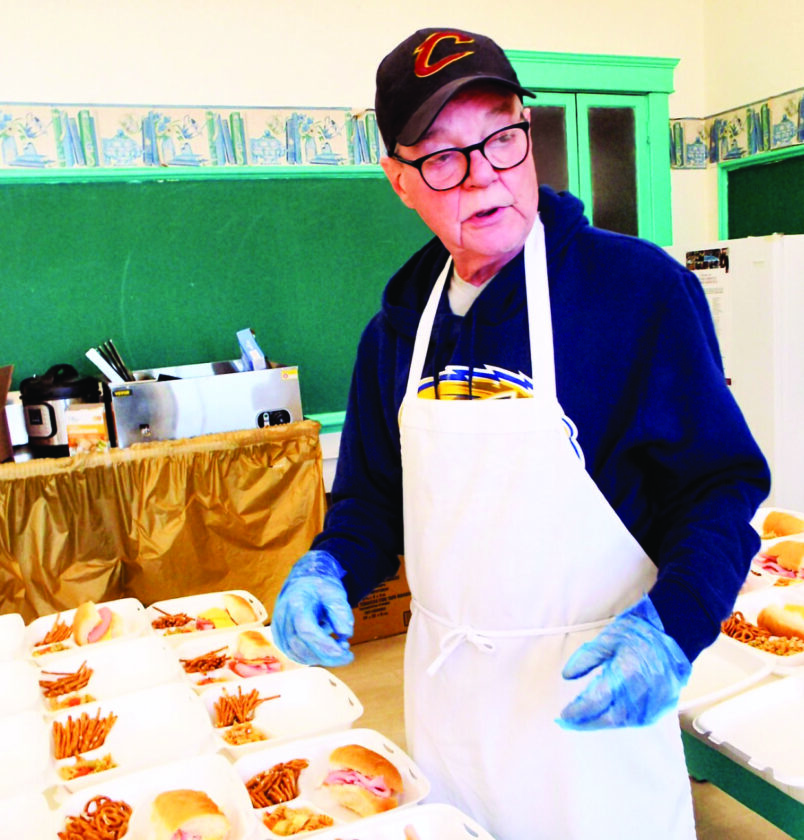County agencies respond to SNAP cut-off due to federal shutdown

Howard Reynolds, who helps his wife Denise, coordinate Shepherd’s Table meal offerings for the Community Resource Center on Mondays, Wednesdays and Fridays, inserts helping of chips or pretzels in the carryout meal containers Monday. Appreciative diners waited in line for around an hour before doors were open, so they could retrieve their meals. (Photo by Stephanie Ujhelyi)
LISBON — During a presentation to a Salem social organization, George Hays explained that 17.8 percent of Columbiana County residents, or 19,000 people, would fall into the status of food insecure.
This came months before the U.S. Department of Agriculture announced that the “well has run dry” in reference to its public notice that it was cutting off SNAP benefits starting in November due to the government shutdown.
Hays, who is the executive director of the United Way of Northern Columbiana County, acknowledged that the situation looks bad, expressing special consideration for children and senior citizens.
It would cost $5 million to keep the fund flowing through November, and there has been some debate if suggestions of tapping contingency funds as the source would be a permittable use — especially since this isn’t a natural disaster like a hurricane.
While some states have taken action to keep their SNAP benefits flowing, like West Virginia, others have either just concentrated on WIC or done nothing all together.
The situation in Ohio still is fluid, explained most local officials.
Politicians are looking at different remedies at the state and federal level in the hopes of a “Hail Mary” solution.
U.S. Sen. Jon Husted (R-Ohio) shared in a press release issued Tuesday that he had written a letter to the financial clerk of the U.S. Senate, asking to withhold his own salary for the duration of the shut down as well as expressed his support for Senate Bill 3024, also known as the Keep SNAP Funded Act of 2025.
“About 1.4 million Ohioans rely on SNAP to put food on the table. Ohio families should not pay the price for Washington’s political game,” Husted explained.
State legislators are working on possible solutions of their own, such as House Bill 502, which would continue funding of SNAP, Temporary Assistance for Needy Families (TANF), and WIC (Supplemental Nutrition Program for Women, Infants and Children) contingent upon a lapse in federal funding by redirecting Controlling Board emergency appropriations out of existing or state funds or allowing temporary transfers from budget reserves out of the Department of Job and Family Services and the Department of Health.
Proposed by State Rep. Latyna Humphrey (D-Columbus) sent a letter to Gov. Mike DeWine, urging him to take action on HB 502.
“Other states are already demonstrating that swift, compassionate action is possible,” Humphrey said in a press release issued Monday.
Earlier this month, West Virginia Gov. Patrick Morrisey fast-tracked $1.1 million in funding to state food banks in anticipation of the delayed SNAP benefits for November.
Louisiana also has authorized up to $150 million per month from state-level resources — outside its rainy day reserve — to ensure continuity of SNAP benefits for children, seniors and individuals with disabilities, Humphrey explained in a press release. “Ohio has long been a leader in pragmatic problem solving, and I believe we can meet this challenge with the same determination.” she added.
If approved, HB 502 bill would provide for full funding for the SNAP program during the government shutdown.
As of press time, both the federal and state legislation still were in the committee stage and hadn’t been up for vote yet, which has resulted in some county agencies instead taking action.
For example, in Northeast Ohio, Summit County provided $250,000 in emergency funding to the Akron-Canton Regional Food Bank on Oct. 27 to help residents at risk of losing their food stamps during the shutdown.
Candy Faloon of the Southern United Way of Columbiana County has no plans to expand offerings to food banks, as the agency already directs around $4,000 per month to the East Liverpool Salvation Army; Community Resource Center on the city’s east end; Catholic Charities, which offers a meal delivery service for seniors; and the Family and Community Services in Lisbon.
Any of these local or state governments should not be expecting reimbursement for funds paid out, as the federal government already had said that would not be happening.
Many local front line officials are recommending recipients to take advantage of local hot meal and pantry programs in the meantime.
However, the food insecure shouldn’t overlook still applying for programs like SNAP and WIC, as they can potentially start receiving benefits once they are reinstated.
Both Lisa Smith of the House of Grace Resource Center in East Liverpool and Chaney Nezbeth of the Way Station, which has three county locations, explain that the majority of their clientele would qualify for SNAP benefits, meaning that their entities will be impacted.
Both expect to have a greater demand for the food resources they have — especially if they cannot increase quantities to fulfill that need.
For example, the Way Station currently purchases 10,000 pounds of food each month from Second Harvest Food Bank for its Columbiana and East Liverpool location.
They, like others close to the front lines, especially worry about the elderly, which is a large percentage of their clientele who have come to rely on SNAP to fill their cupboards with food.
Without receiving those benefits, the money that they use to pay rent, medical bills and for medication may instead go toward food.
However, Rachel Ketterman, director of the Columbiana County Job and Family Services, reminds those older folks that there are assistance programs for most of that as well if needed, so be sure to apply for those.
She also explained that more than 14,000 recipients get SNAP benefits in Columbiana County, so her staff is concentrated right now in this final hours with providing them those possible resources to pursue now that the state and federal government have notified them of the SNAP funding situation.
Ketterman estimated that $2 million worth of SNAP benefits are administered to county residents monthly.
That is why programs such as Shepherd’s Table, which offers hot meals at the CRC three days a week, is so important for many of these recipients.
Lines start to form well in advance at the CRC front door on food days, as area residents await their free carryout meals.
Denise Reynolds, a force behind Shepherd’s Table, explained as she prepared Monday’s lunch that she had been approached in spring by CRC executive director Denise Taylor, after she had volunteered to oversee some kind of public prepared food meal program.
Now 39 weeks later, Reynolds speculates that she and her volunteers have served more than 3,000 meals (40 to 45 weekly) to various East Liverpool clients who struggle with food insecurity.
Additional resources offered to cope with the crisis, include:
— Noting the list of available pantries shown in Columbiana and northern Hancock counties.
— Check with local school districts to see about possible resources, such as school building pantries or weekend backpack programs.
— Establishment of a shelf-stable pantry with mainstays like rice, beans and pasta, which can provide meals for days.
–During the growing season, many communities have public gardens that generate produce.
— For parents with children under age 5, apply for WIC now. It is separate from SNAP and still running in most states.
— Some entities may have either Blessing Boxes for shelf-stable staples or a community refrigerator. These “take what you need, leave what you can” are a popular option if any are near you.
sujhelyi@mojonews.com



